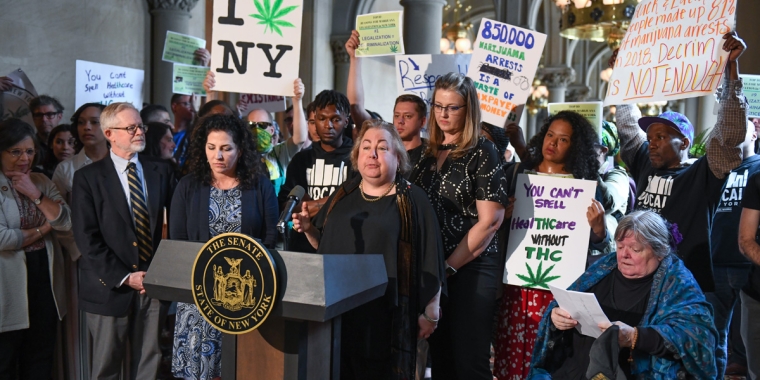
Sen. Krueger's Testimony on the First Avenue Estates' Landmark Application
Liz Krueger
July 1, 2013
Sen. Krueger submitted the following testimony to the Landmarks Preservation Commission for its June 11 public hearing considering the First Avenue Estates.
My name is Liz Krueger and I represent the 28th State Senate District, which includes the Upper East Side, East Midtown and Midtown neighborhoods of Manhattan. I regret that because the State Senate is in session in Albany today I am unable to attend in person.
I appreciate the opportunity to express my strong opposition to the building owner’s application to demolish 429 East 64th Street and 430 East 65th Street (429 and 430), individually landmarked buildings which were constructed as part of the City and Suburban Homes Company’s First Avenue Estate. Based upon my review of the owner’s latest submissions supporting the hardship application, and the analysis conducted by a number of the historic preservation organizations in my community, I believe that the owner's claims that a reasonable profit cannot be generated from the properties are entirely disingenuous. If this application is approved, it would be devastating to the residents of 429 and 430, set an extremely dangerous precedent, and undermine the entire New York City landmarking process.
The Landmarks Preservation Commission (LPC) found in 1990 that the City and Suburban Homes Company was the most successful of the privately financed, limited-dividend companies that attempted to address the housing problems of the nation’s working poor at the beginning of the twentieth century. 429 and 430 reflect both the culture and history of the community in which they are located, as well as a wider movement that aimed to bring better living conditions to all New Yorkers. These buildings served as national examples for the “model tenement” movement in which buildings were designed around an inner courtyard to ensure that every apartment had access to substantial light and air.
I was proud to work with countless residents and community organizations in my district, and my fellow East Side elected officials to ensure that 429 and 430 were finally designated as landmarks. The East Side celebrated the LPC's decision in 2006 to rectify the politically motivated determination made by the NYC Board of Estimate in 1990 to override the LPC and exclude the two buildings when the rest of the complex was landmarked. The community thought that its struggle to preserve the homes of more than 200 residents and two key historical buildings was finally complete. Unfortunately the owner has chosen to drag the process on, causing undue stress on residents and wasting time and resources that could have been used better for restoration of the buildings.
I would like to place particular focus on the content found within this latest submission, much of which falls short of achieving basic credibility. The owner continues to present dramatically undervalued estimations of expected income as a means to prove an inability to obtain an acceptable return on investment. The owner claims that after a $17 million renovation, or $52,000 per apartment, the average amount that could be charged for monthly rent would be $1,235 and that the properties would still be burdened by a 10% vacancy rate. The submission of this claim implies that affordable rental units on the Upper East Side are somehow in low demand. Having represented the Upper East Side and residing in Manhattan for many years, I find these claims to be wildly unrealistic. In fact, the average vacancy rate on the Upper East Side during the test year was 2.38%, and a study conducted by HR&A maintains that comparable units in the area average a monthly rent of $1,500. Simply by adjusting these figures to reflect a reasonable vacancy rate and average expected rent, the applicant would increase their return on investment by 11.7%, nearly double the necessary amount for a hardship determination. Additionally, the applicant has continually adjusted their expected income from individual units throughout the application process from $600 to $888 and now $1,235. This progression further confirms the applicant’s lack of credibility.
My office constantly receives calls from people looking for affordable housing options. In fact, my office recently worked with a constituent looking for an apartment in the area who was unable to get in touch with a leasing agent or management official of these properties after visiting the office, finding it closed, and leaving several messages inquiring about available units. It is likely that this is not an isolated incident. This particular individual was prepared to pay up to $2,000 per month and move in immediately. If actually offered at the indicated price of $1,235, these units would undoubtedly be filled. The applicant’s claim can only be a reflection of either incompetent management or an intentional misrepresentation of a highly competitive rental market. This is further reflected by the applicant’s response to question 41 (a) “The applicant does not maintain records of the number of people who have either inquired about renting, or applied to rent, an apartment in the Subject Buildings or the Other Buildings.” It is clear that the applicant has thus far failed to properly market, or even respond to inquiries about, their available units. This must be taken into consideration when evaluating the applicant’s claims.
New York City and the courts have created a process for owners of landmarked properties to apply to the LPC for permission to demolish their buildings only in the extremely limited circumstances in which they were “incapable of earning a reasonable return….under reasonably efficient and prudent management.” The hardship application process must be limited to truly distressed properties that cannot generate reasonable profits under any circumstances. The miscalculated rental potential of the buildings in the owner’s application, along with the warehousing of more than 50% of the units reveal that any hardship taken on by the management of these two properties has been self inflicted and can be easily corrected.
I urge the LPC to deny this application outright, recognizing its distorted figures, the overall negative impact it would have on current residents and the community, as well as the general integrity of the Landmarks Law. Thank you for allowing me to speak on this issue today and I hope the LPC will take into account the many voices that have spoken in opposition to this application.
Share this Article or Press Release
Newsroom
Go to Newsroom

